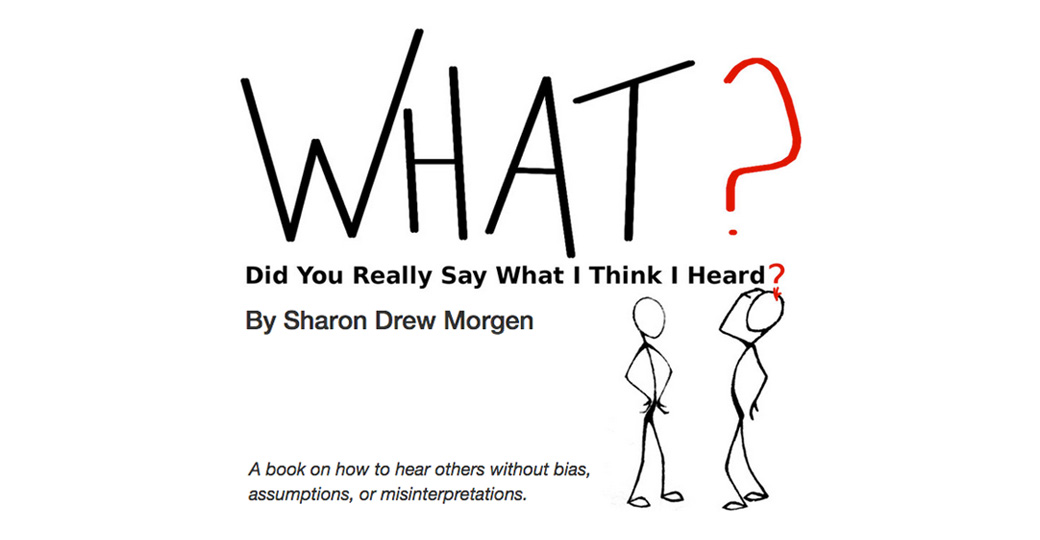 I recently heard yet another excuse as to why a buyer didn’t buy. This one was a hoot – seller/buyer misalignment. Seriously? Because the seller didn’t close a sale (That was expected by the seller? In the mythical pipeline?) there was a relationship problem? Because the buyer didn’t buy (according to the expectation of the seller) there was a bonding problem? No. The problem stems from sellers not understanding what a buyer is. In this case, there was no buyer to be ‘misaligned’ with.
I recently heard yet another excuse as to why a buyer didn’t buy. This one was a hoot – seller/buyer misalignment. Seriously? Because the seller didn’t close a sale (That was expected by the seller? In the mythical pipeline?) there was a relationship problem? Because the buyer didn’t buy (according to the expectation of the seller) there was a bonding problem? No. The problem stems from sellers not understanding what a buyer is. In this case, there was no buyer to be ‘misaligned’ with.
FROM PERSON TO BUYER
A decision not to purchase has very little to do with the seller, the solution, the relationship, or the need. In fact, a purchase is the very last thing a buyer wants. Just because a situation seems like a perfect fit with your solution does not make it a buying/selling opportunity; just because someone really needs your solution does not mean they are ready, willing, or able to buy.
Let me begin by defining ‘Buyer’: a person (or group) who has
- assembled all people, causes, and elements that created their problem AND
- recognized they cannot fix the problem with familiar resources, AND
- gotten buy-in from everyone/everything involved with the changes a fix would affect, AND
- met a collection of personal/group criteria that assures eventual stability, AND
- decided that the cost of a fix is lower than maintaining the status quo,
and decides to purchase an external solution as their only option.
As the thought-leader behind how buyers buy (programs developed, books written, modelsinvented, steps defined, terms coined, since 1985) I’d like to offer some thoughts:
1. A buyer isn’t a buyer unless they’ve bought something. Until then they are people with a problem that may, if all else fails, require an external solution.
2. People first recognize a problem that keeps them from the type of Excellence they require. They may or may not decide to fix it. It never begins as a decision to make a purchase (unless a small personal item).
3. There are usually a range of ‘fixes’ available for problems. Workarounds are always the first option, a purchase the last.
4. All people (buyers, groups, individuals) live in a unique unconscious, human system (rules, relationships, beliefs, experience, goals, etc.) that created the problem and maintains it as part of their status quo. The system exists AS IS, with problems factored in. If an element is recognized as problematic, the system would need to agree on possible forward routes. Any change would need to end up as an integrated part of the core system.
5. A purchase means something new will enter the system and replace or reconsider what’s already there without leaving a mess. It’s only when there’s agreement from all elements that created the problem that
* it can’t be fixed with known resources or workarounds,
* the cost in resources/change is lower than the cost of fallout,
* a path forward is defined by everyone who will touch the final solution,
that the full scope of a solution is understood. Until then ‘need’ isn’t fully defined. Here is where sellers often get caught thinking there’s a ‘need’ before there is one.
6. There is a defined series of 13 (generic) steps that all systems traverse (often unconsciously) to decide if, when, why, how, what to change. Until they’ve agreed they can’t fix the problem with familiar resources AND developed a plan for congruent change, (step 10), there is no willingness to seek an external solution. In other words, people become buyers at step 10; before that they’re merely people trying to fix a problem themselves.
7. During the steps of change, people within the system do research to find a variety of ideas that could possibly help them fix their problem themselves. If they have contacted a solution provider during their research phase (and have not yet gotten group buy-in) they’re not buyers regardless of their apparent need and the efficacy of a seller’s solution.
8. Making a purchase is first a change management issue, last a solution choice problem; the first question people ask is how they can achieve Excellence without leaving an internal mess; the last question they ask is what solution they’d need from ‘outside’. Using the sales model, only solution placement criteria and activities are considered and any questions posed are biased to inspire agreement, admission of need, ‘relationship’ – all with an intent to sell something (i.e. steps 10-13); there is no element of the sales model that facilitates systemic change to enable sellers to enter earlier.
9. Until any disruption caused by a purchase (i.e. all purchases are ‘foreign’ elements) is understood, planned for, and agreed to, no purchase will take place. The existing system is sacrosanct; keeping it running smoothly is more important to them than fixing a problem that’s already been baked into the system.
10. Everyone and everything who created the current problem and would potentially touch a new solution must agree to any modification (possible purchase). Until then, they won’t, they can’t buy and they are not buyers.
11. The time it takes people/buyers to discover their own answers and know how to manage change in the least disruptive way, is the length of the sales cycle. It has nothing to do with selling, buying, need, relationship, content, or solutions until the route to congruent change is defined and agreed to. It’s change management issue before it’s a solution choice issue.
12. The last thing people want is to buy something. With their only criteria of ‘solution placement’, sellers often enter at the wrong time in the buying journey, ask the wrong questions, and offer the wrong data – and sell only to the low-hanging fruit (the 5% who have planned their route to change already).
13. Buyers buy using their own buying patterns, not a seller’s selling patterns. Using a specific type of sales effort further restricts the population of those who will buy.
14. There is a difference in goals, outcome, capability of changing, and level of buy-in between those who CAN/WILL buy (based on congruent change) vs those who sellers think SHOULD buy (based solely on need/solution match) and hence waste a helluva lot of time.
15. The time it takes people to come up with their complete set of buy-in and change-based answers is the time it takes them to make a decision to seek an external solution – i.e. become a buyer. It has nothing whatsoever to do with their need, your solution, or your relationship until they are certain they will end up with Systems Congruence. And THEN they are ready to discuss the full complement of needs, criteria for buying a solution, and seek a compatible relationship with a seller.
HOW SALES RESTRICTS POSSIBILITY
Because we’ve restricted selling to placing solutions, people with problems we could resolve slowly figure out their own path to change while we sit and wait for those who have completed their process to show up. Prospective buyers, facing confusing choices, would be happy to have help navigating through their Pre-Sales systemic decision/change process and adding a true facilitator onto their BDT.
Right now, you’re seeking out those people you’ve determined SHOULD buy (and getting ignored, misaligned, dropped, etc.) and ignoring ways to facilitate those who CAN buy but haven’t yet become buyers. If you enter with a Change Facilitation focus, it’s possible to find those who CAN buy on the first call, and use your relationship and knowledge to facilitate them through the steps of the change management process first, and THEN be there as they determine the need for your solution.
By adding a Change Facilitation processes to your upfront tools (seller-, marketing-, or software-led) you can enter at any step along the Buying Decision Path and be part of the BDT to help them get their ducks in a row. Then you’ve gotten ahead of the competition, reduce your sales cycle by half, only connect with those who WILL buy, close a helluva lot more sales (my clients close 5x more than the control groups using the same lists), and truly serve the people who need you.
I’ve developed a model (Buying Facilitation®) that uses wholly unique skills (Listening for Systems, Facilitative Questions, etc.) to facilitate the discovery of a congruent route to Excellence. A generic model used for coaching, management, leadership, healthcare, I’ve been quite successful teaching it to global corporations ( i.e. IBM, Kaiser, Wachovia, KPMG, etc.) to increase their sales. Currently you’re now wasting 95% of your time running after those few who have finally arrived at step 10 – the low hanging fruit – ignoring the much larger pool of those who are on route, and fighting for a competitive advantage.
By adding new functionality to your sales model, you can enter earlier, be a Servant Leader, and facilitate congruent change and THEN be on board and accepted as a provider as they go through their buying decision process. It’s NOT sales; it’s NOT selling/purchase-based; it IS change-based. Right now you’re waiting while buyers do it anyway (or merely running after those you THINK have a need but end up fixing the problem in other ways). Why not add a skill set, stop wasting time/effort, and close more. Then you’ll never be ‘misaligned.’
____________
Sharon Drew Morgen is an original thinker and thought leader. As the originator of Change Facilitation, she invented Buying Facilitation® for the sales industry; she’s trained over 100,000 sellers globally to diverse industries and cultures. Sharon Drew is the author of 9 books, including the NYTimes Business Bestseller Selling with Integrity, and the Amazon bestsellers Dirty Little Secrets: why buyers can’t buy and sellers can’t sell, and What? Did you really say what I think I heard? Sharon Drew works with individuals and teams as a coach, speaker, trainer, and consultant, in sales, change implementations, healthcare, technology. Her work on listening without bias has been called ‘game-changing’ and is used by corporations globally. Contact her at sharondrew@sharondrewmorgen.

